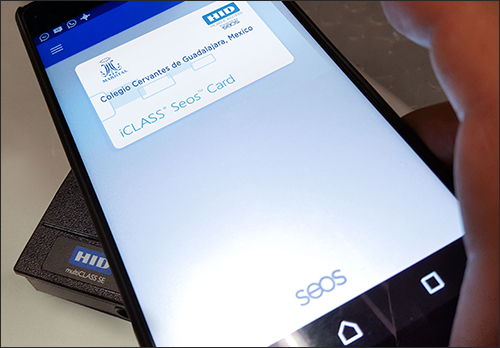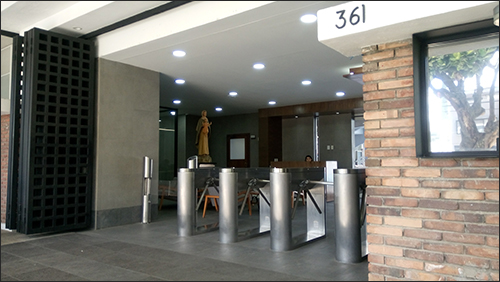Cervantes High School (Colegio Cervantes), in Guadalajara, Mexico, launched the school year this fall with a hybrid system based on Near Field Communication (NFC) and Bluetooth Low Energy (BLE) technologies, to manage the movements of its students and staff into its campus. The solution, provided by Mexican systems integrator Amcorp Security Group Mexico, utilizes wireless access-control technology from HID Global, known as HID Mobile Access. The system consists of both NFC-enabled iCLASS Seos smart cards and BLE-based applications to provide two ways for people to present their credentials.
Since the system was taken live, it has made the school a showcase institution for other schools and organizations looking to improve access control and safety management, says Alejandro González González, Cervantes High School’s principal. The technology has enabled the school to ensure that unauthorized individuals cannot enter the campus, and to better understand who is on campus at any given time, and for how long.

Prior to the system’s installation, Cervantes High School wanted to have a safer campus without compromising the user experience, says Harm Radstaak, HID Global’s VP and managing director for physical access control. The school consists of an open campus, meaning visitors could easily access the grounds. However, he notes, the open environment has posed security risks for students, employees and property. For instance, the school had been experiencing an uptick in on-campus theft.
Earlier this year, the school approached Amcorp Security Group and said it had several requirements for the solution it sought to implement. While it wanted to better manage who came and went from the campus, it did not want to create bottlenecks or confusion. The school also required that any technology-based solution would not make daily entrance to the facility more difficult for its roughly 1,500 students, teachers, administrative personnel and service employees.
Those accessing the school range from young, technology-savvy students to older personnel who may not be comfortable with mobile app-based technologies. The school thus sought a system that anyone could easily understand, regardless of their level of comfort.
The system that the high school opted to deploy consists of 1,500 NFC-enabled HID Global Seos cards, as well as a BLE-based mobile app, thereby providing an option for individuals to use the badge or their mobile phone for identification. ID Global’s multiCLASS SE readers are installed at the school’s entrance and exit, with built-in 13.56 MHz NFC readers compliant with the ISO 14443 standard. They also come with BLE beacons that transmit a unique signal to BLE-enabled phones.
In time for the school year this fall, Amcorp installed the multiCLASS SE readers at the entrance, where individuals walk through turnstiles. With the system in place, a user first provides the school with his or her cell phone number or e-mail address. That inividual can then receive an invitation to register his or her phone. Upon opening that invitation, he or she is instructed to download the mobile app for the iOS or Android device. That person can then retrieve a mobile credential in the form of a unique ID number.
Any phone with BLE functionality built into it can capture data from the entrance beacon and forward its own credential to the hosted server via the app. For those using NFC, the ID card comes with a unique identifier encoded on a built-in NFC chip. That information is input into the software in order to link the ID with the corresponding student or staff member.
Each day, as individuals arrive at the school, each must first proceed to one of several kiosks installed at the school’s entrance turnstiles, then present either a mobile phone or an NFC ID card. The software identifies the individual, confirms that he or she is authorized to enter, and prompts the turnstile to rotate, allowing that person to enter.

The software not only controls access, but also creates a record of who has entered and left the facility, as well as when this occurred. The system also enables visitors to acquire temporary badges that they carry through the turnstiles.
Offering two technology solutions to each user, Radstaak says, provides flexibility. “Because Cervantes School wanted to give users the latest technology it could offer, as well as a choice,” he states, “it has provided the option of mobile IDs, as well as Seos smart cards.”
“The solution has drawn a lot of attention from other schools who visit the campus for sporting and other events,” González says. “Being able to present campus IDs using their mobile phones has been particularly attractive to students, because of its convenience and novelty.”
The next step, González says, is to use the technology at the entrance to each classroom, in order to potentially control access to every room. In the meantime, he adds, the Cervantes educational community—users of the solution—”has given the new system very positive reviews and said that they feel much safer.”
In the meantime, technology provider HID Global is growing. This week, the company announced acquisition plans for Mercury Security, a supplier of physical access-control hardware. HID Global reports that Mercury Security has installed more than three million controllers at tens of thousands of sites worldwide. Mercury also offers interface boards and software for access control.


